Ijraset Journal For Research in Applied Science and Engineering Technology
- Home / Ijraset
- On This Page
- Abstract
- Introduction
- Conclusion
- References
- Copyright
Survey based Study on Levels of Radiation Safety Awareness among Non-Radiology Staff
Authors: Aman Raj , Nazreen Sultana , Bablu Kumar , Saurav Siddharth , Anjali Dhadwal
DOI Link: https://doi.org/10.22214/ijraset.2023.56360
Certificate: View Certificate
Abstract
Background: The recent years have witnessed a notable surge in the utilization of Ionizing Radiation, primarily driven by advancements in diagnostic technology within the Radiology field. However, it\'s crucial to acknowledge that exposure to such radiation poses significant risks to both healthcare professionals and patients. Ionizing radiation comes with various disadvantages and potential harmful effects, the severity of which depends on the dose and duration of exposure. Recent reports have underscored the imperative need to enhance our understanding of ionizing radiation and its associated risks. Methods: A cross-sectional questionnaire survey was carried out within the Swami Vivekanand Group of Institutes. A total of 101 participants, excluding those from the Radiology and Operation Theatre departments, completed a questionnaire consisting of 15 multiple-choice questions. There were no age restrictions for participation, and the identities of the participants remained anonymous. The only eligibility criterion was that participants should not be affiliated with the Radiology and Operation Theatre departments. Each participant was provided with a self-administered questionnaire, and over a span of 45 days, their knowledge about radiation safety. Results: A survey using questionnaires was conducted, with participation from 101 individuals who were not part of the radiology department and Ott department. Subsequently, the collected data was analyzed. The respondents represented various professions, including staff, teachers, business professionals, advocates, lawyers, engineers, mechanics, clerks, assistant professors, and others. Conclusion: Patient safety is of utmost importance in any medical procedure. Regrettably, healthcare professionals frequently have insufficient knowledge about radiation risks and protective measures. In our study, only a modest number of participants attained perfect scores, highlighting the insufficient level of awareness among others who scored significantly lower.
Introduction
I. INTRODUCTION
The knowledge of ionizing radiation exposure risks among the non-radiology staff is essential for protecting themselves from the diagnostic procedures and therapy, as well as the necessary measures that are to be taken in common radiological examinations is very important. The recent dramatic evolution and increased use of ionizing radiation-based diagnostic modalities such as multidetector computed tomography (CT) has led to a multiplication of the number of examinations and hence of the overall radiation exposure to the population, with CT currently accounting for about 50% of the total radiation burden for medical purposes This will aid the healthcare providers to plan the procedures and protocols using ionizing radiation and to also protect patients better as well as themselves. If there is a lack in knowledge about radiation protection amongst the non-radiology professionals working around ionizing radiation, then they put themselves in a position where they cannot protect themselves effectively as well as others. According to our knowledge there are very few studies reported on the knowledge and awareness of radiation safety among the non-radiological staffs. Evaluation of the knowledge of radiation safety during diagnostic procedures among the medical staff as well as nonmedical staff are necessary. Our study aims to evaluate the knowledge of radiation safety among the non-radiology healthcare professionals, who work in different departments those who do not use ionizing radiation, regarding radiation awareness and radiation safety1.
The use of Ionizing Radiation has increased in the recent years, with the advancements in diagnostic technology in the field of Radiology. Exposure to radiation is hazardous to both healthcare worker and patients. Ionizing radiation has various disadvantages and detrimental effects as well depending on the dose and duration of the exposure. In numerous recent reports, the conditions of the knowledge of ionizing radiation have been brought to the attention. Many researchers report revealed that there is insufficiency in knowledge about radiation safety among the respondents working in around the radiation area and poor knowledge about doses that the received in common radiological examinations.1
Understanding the risks associated with ionizing radiation exposure is crucial for non-radiology staff to safeguard themselves during diagnostic procedures and therapy. It's essential for them to be aware of the necessary precautions during common radiological examinations, especially as technologies like multidetector computed tomography (CT) become more prevalent. CT scans now contribute significantly to medical radiation exposure, highlighting the need for proper protocols. This knowledge empowers healthcare providers to plan procedures and protect both patients and themselves effectively. However, the lack of awareness about radiation protection among non-radiology professionals can hinder their ability to ensure safety. Limited studies have addressed radiation safety awareness among nonradiological staff. Assessing the knowledge of radiation safety in both medical and non-medical personnel is vital. Our study aims to evaluate radiation safety awareness among non-radiology healthcare professionals working in different departments, even if they don't directly use ionizing radiation. The escalating use of ionizing radiation in modern diagnostics demands a better understanding of its risks and safety measures to ensure the well-being of both healthcare workers and patients. Recent reports have highlighted the insufficient awareness about ionizing radiation, including poor knowledge about radiation doses received during common radiological procedures.1
II. METHODS AND MATERIAL
A cross sectional questionnaire survey study was conducted in swami Vivekanand group of institutes. A total of 101 participants (except radiology and operation theatre staff) were responded a questionnaire and in that there was 15 multiple choice question. There was no age limit for this study. The participant’s identity was kept anonymous. The minimum eligibility of the participants was that they should be not from the department of radiology and ott . Each of the participants were given self-administered questionnaire.
III. REVIEW OF LITERATURE
A. The Level of Radiation Safety Awareness among Non-radiology Staff
This study was conducted by DEHGHANI ALI1 , MOHAMMAD RANJBARIAN etc. The aim of their was to evaluate the radiation safety condition and the level of radiation safety awareness among nonradiology staff in 18 hospitals of shahid beheshti university of medical sciences, Tehran,Iran.
This descriptive, cross-sectional study was administered to patients and personnel, also making a review on the radiation-safety status in the hospitals. In evaluating the level of awareness, 100 patients and 173 staff took part in the survey. A12-question inventory was used for evaluating radiation-safety status.
In addition, 2 quesstionnaries used included personal and general questions and its validity and reliability had been confirmed (cronbach’s alpha = 0.711). The results have shown 71.1% good radiation-safety awareness among staff. Moreover, the level of staff awareness was not associated with educational level, gander, field of study, age and job experience. Conversely, only 6% of the patients have shown a good awareness level. In addition, as it depicted by the results there was a significant relation between awareness level and age.
B. Radiology Nurses’ Awareness of Radiation Muhammad Alotaibi BSN, MSN, PhD.
The purpose of this study was to explore the awareness level of radiation risks and protection among radiology nurses in Kuwait. The results showed that the vast majority of these nurses were not aware of radiations risks and the most important aspects of radiation protection. In addition, they expressed their fear of radiation and their interest to learn more about it. Implementation of courses on radiation for nurses was recommended.3
C. Radiation Safety Knowledge and Practices Among Urology Residents and Fellows: Results of a Nationwide Survey
The study was conducted by Ariella A. Friedman MD. Overall, 165 trainees responded, almost all of whom reported at least weekly workplace radiation exposure. Compliance with body and thyroid shields was high at 99% and 73%, respectively. Almost no one used lead-lined glasses and gloves; three-quarters cited lack of availability. The principle of keeping radiation doses As Low As Reasonably Achievable (ALARA) was widely practiced (88%).
However, 70% of respondents never used dosimeters, while 56% never had one issued. Only 53% felt adequately trained in radiation safety; this number was 30% among those pregnant during training. Fewer than half (46%) correctly identified the maximum acceptable annual physician exposure. Departmental education in radiation safety improved knowledge, protective practices, monitoring, and satisfaction with education in radiation exposure.4
IV. DATA ANALYSIS
The questionnaire-based survey was performed. It was given to 101 numbers of non-radiology staff individually. After that the data was analysed. Responses was from professions like - Staff, teacher, business, advocate, lawyer, engineer, mechanics, clerk, assistant professor and other.
In this study 86.10% participants knew about that the radiation hazards. But 13.90% participants did not know about the radiation hazards.
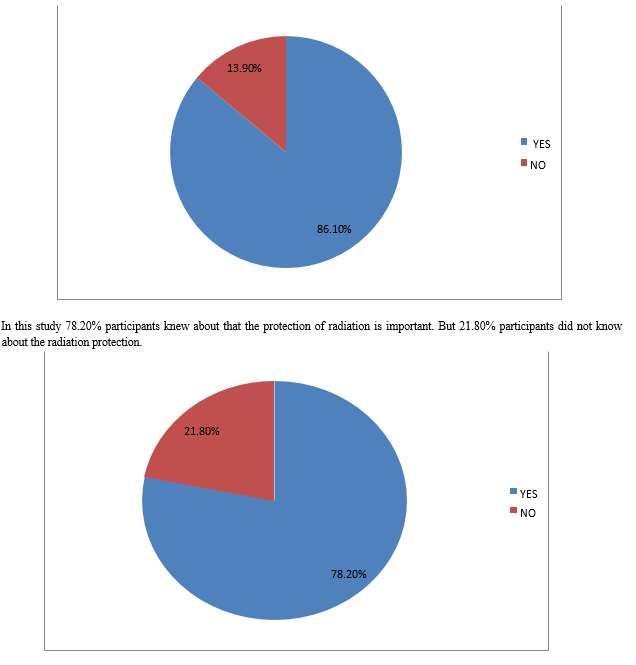
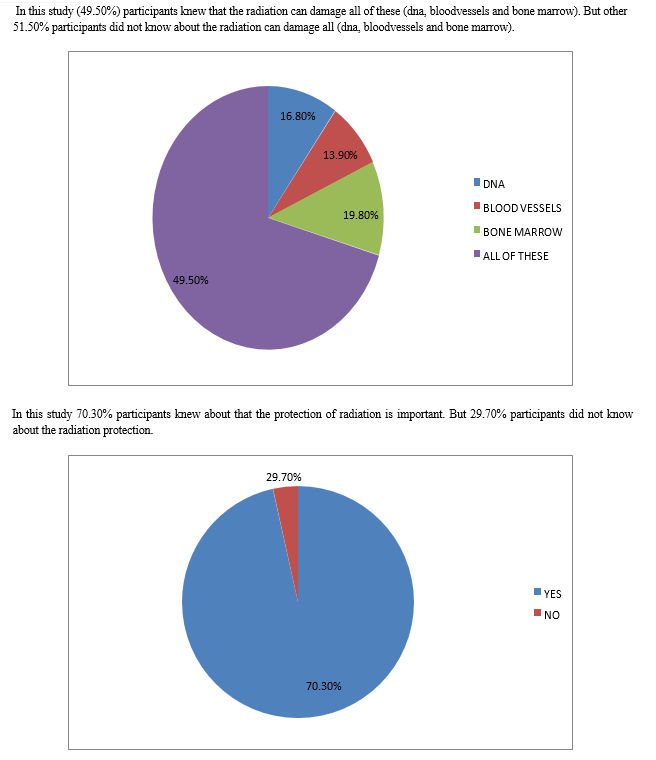

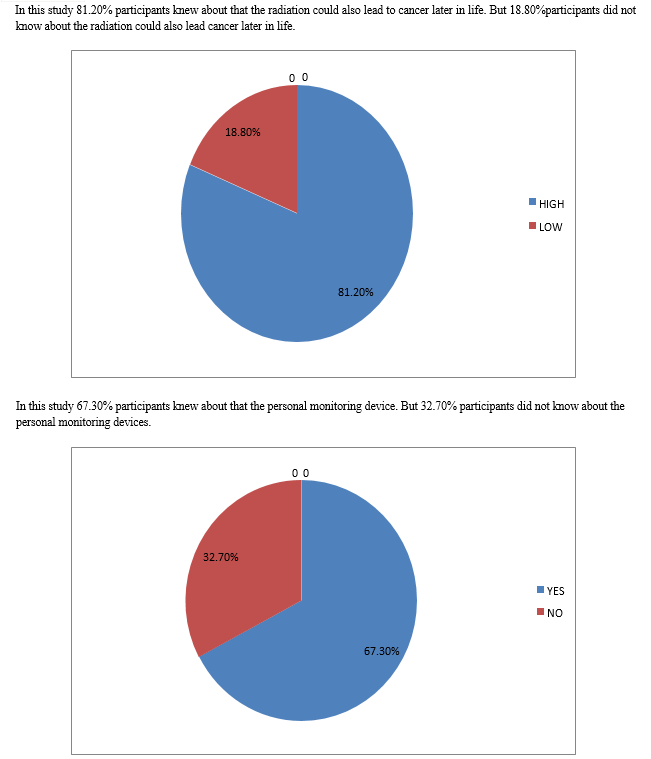
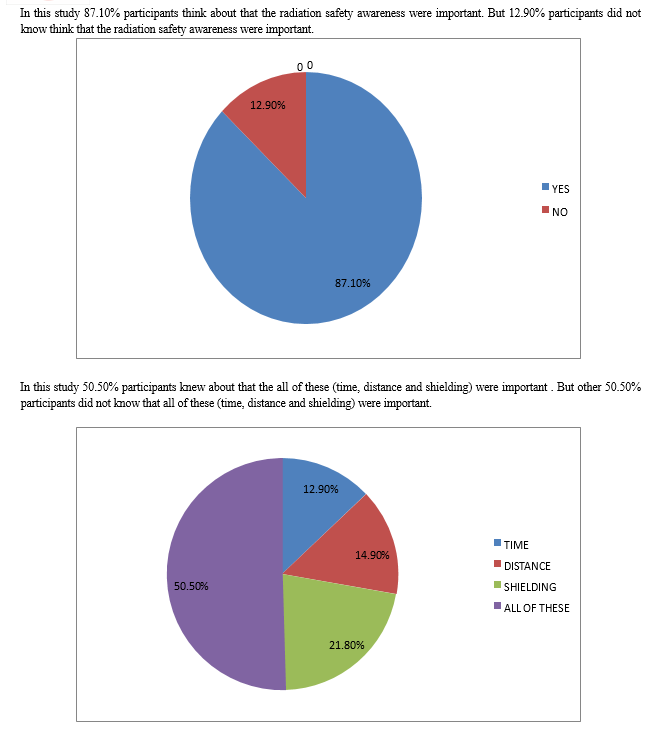
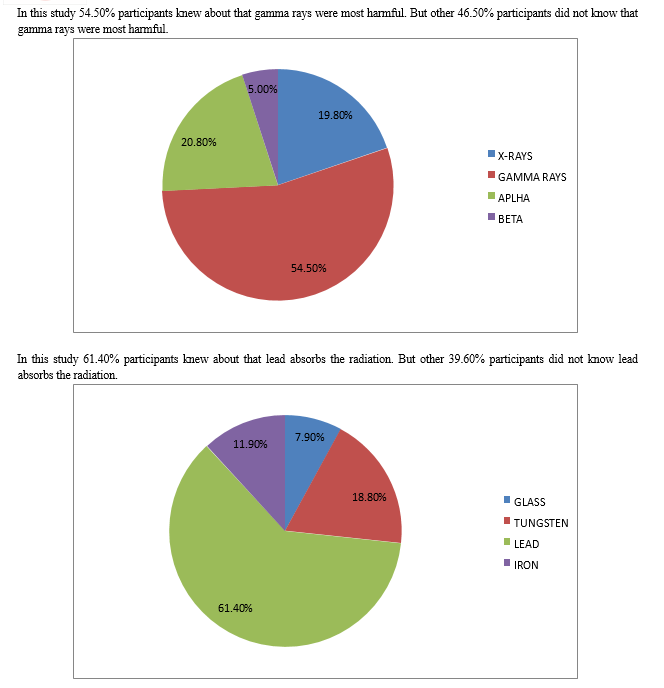
V. RESULT
The questionnaire-based survey was performed. It was given to 101 numbers of non-radiology staff individually. After that the data was analysed. Responses was from professions like - Staff, teacher, business, advocate, lawyer, engineer, mechanics, clerk, assistant professor and other.
In this study 86.10% participants knew about that the radiation hazards. But 13.90% participants did not know about the radiation hazards. In this study 78.20% participants knew about that the protection of radiation is important. But 21.80% participants did not know about the radiation protection. In this study (49.50%) participants knew that the radiation can damage all of these (DNA, blood vessels and bone marrow). But other 51.50% participants did not know about the radiation can damage all (DNA, blood vessels and bone marrow). In this study 70.30%participants knew about that the protection of radiation is important. But 29.70% participants did not know about the radiation protection. In this study 74.30% participants knew that the radiation can cause cancer. But 25.70% participants did not know about the radiation can cause cancer. In this study 66.30%% participants knew about that the radiation lower the immune system. But 33.70% participants did not know about the radiation lower the immune system. In this study 81.20% participants knew about that the radiation could also lead to cancer later in life. But 18.80%participants did not know about the radiation could also lead cancer later in life. In this study 67.30% participants knew about that the personal monitoring devices. But 32.70% participants did not know about the personal monitoring devices. In this study 87.10% participants think about that the radiation safety awareness were important. But 12.90% participants did not know think that the radiation safety awareness were important. In this study 50.50% participants knew about that the all of these (time, distance and shielding) were important. But other 50.50% participants did not know that all of these (time, distance and shielding) were important. In this study 54.50% participants knew about that gamma rays were most harmful. But other 46.50% participants did not know that gamma rays were most harmful. In this study 61.40% participants knew about that lead absorbs the radiation. But other 39.60% participants did not know lead absorbs the radiation.
VI. DISCUSSION
The safety of patients and staff is a priority of every diagnostic or therapeutic procedure involving ionizing radiation. Medical staff in contact with ionizing radiation must proceed in accordance with the As Low As Reasonable Achievable (ALARA) principles. This includes performing the scans with possibly lowest doses of ionizing radiation allowing to obtain the desired diagnostic effect.2 The number of studies regarding the awareness of radiological protection issues in medical staff regardless of position is low.2 The everyday clinical practice and incorrect, and sometimes contradictory provided by the non- medical staff have instigated us to attempt to determine the radiation protection awareness among the non- medical staff.2 The study group purposefully excluded (radiology & Ott department) According to the original premises, the study group should also be diverse in terms of the place and length of service.2 The obtained results provided interesting information on the knowledge, expertise and convictions of medical professionals as regards radiation protection.2 Good knowledge of the full spectrum of ionizing radiation effects among the employees of radiology departments is not surprising due to their specialist background.2 It is, however, very difficult to explain the low level of knowledge of the properties of ionizing radiation among oncology staff. This is all the more surprising that patients referred to diagnostic examinations from oncology units constitute a high percentage of all patients being diagnosed in every medical institution.2 Another interesting conclusion is the low level of overall knowledge of radiographical procedures among the non-radiology staff. It is particularly curious in the context of care they provide to hospitalized patients and to their active participation in preparation for scheduled imaging examinations.2 The analysis revealed a relatively low level of knowledge on ionizing radiation among the study population. 2 The importance of prioritizing safety in medical procedures involving ionizing radiation, emphasizing the As Low as Reasonably Achievable (ALARA) principles for minimizing radiation exposure.2 Numerous research studies have highlighted a lack of adequate knowledge concerning radiation safety among individuals working with ionizing radiation. Additionally, there is a noticeable deficiency in understanding the doses of radiation that patients commonly receive during radiological examinations.2 Our research to assess the understanding of radiation safety among healthcare professionals from non-radiology departments, who are not exposed to ionizing radiation. The focus is on their awareness of radiation and adherence to safety measures.2 The analysis revealed a relatively low level of knowledge on ionizing radiation among the study population. 2 The importance of prioritizing safety in medical procedures involving ionizing radiation, emphasizing the As Low As Reasonable Achievable (ALARA) principles for minimizing radiation exposure.2
Conclusion
Ensuring patient safety takes precedence during any medical procedure. Unfortunately, healthcare professionals often lack adequate understanding of radiation hazards and protective measures. In our study, only average number of participants achieved perfect scores, while others scored very low, signifying inadequate awareness levels. Addressing this gap requires comprehensive training and education about radiation hazards and safety for all healthcare professionals within medical facilities. To achieve this goal, it\'s advisable to incorporate lectures on radiation protection and integrate radiation awareness and safety into healthcare worker education.
References
[1] Szurowska, Edyta. “Radiation Safety Awareness Among Medical Staff.” Polish Journal of Radiology, vol. 80, Termedia Sp. z.o.o., 2015, pp. 57–61. Crossref, https://doi.org/10.12659/pjr.892758. [2] Alotaibi, Muhammad, and Raed Saeed. “Radiology Nurses’ Awareness of Radiation.” Journal of Radiology Nursing, vol. 25, no. 1, Elsevier BV, Mar. 2006, pp. 7–12. Crossref, https://doi.org/10.1016/j.jradnu.2005.12.001. [3] Friedman, Ariella A., et al. “Radiation Safety Knowledge and Practices Among Urology Residents and Fellows: Results of a Nationwide Survey.” Journal of Surgical Education, vol. 70, no. 2, Elsevier BV, Mar. 2013, pp. 224–31. Crossref, https://doi.org/10.1016/j.jsurg.2012.10.002.
Copyright
Copyright © 2023 Aman Raj , Nazreen Sultana , Bablu Kumar , Saurav Siddharth , Anjali Dhadwal . This is an open access article distributed under the Creative Commons Attribution License, which permits unrestricted use, distribution, and reproduction in any medium, provided the original work is properly cited.

Download Paper
Paper Id : IJRASET56360
Publish Date : 2023-10-29
ISSN : 2321-9653
Publisher Name : IJRASET
DOI Link : Click Here
 Submit Paper Online
Submit Paper Online

